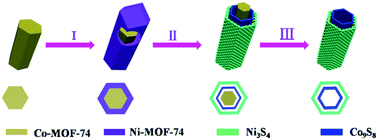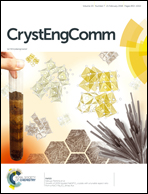Hollow shell-in-shell Ni3S4@Co9S8 tubes derived from core–shell Ni-MOF-74@Co-MOF-74 as efficient faradaic electrodes†
Abstract
This paper reports the novel design of shell-in-shell Ni3S4@Co9S8 double-shelled tube (DST) hierarchical structures with different shell compositions, and the subsequent attempt to fabricate these structures. We fabricated such unique shell-in-shell hierarchical structures through transition from isomorphic metal–organic framework core–shell structures of Ni-MOF-74@Co-MOF-74 in the presence of Na2S under solvothermal conditions. The as-prepared Ni3S4@Co9S8 DSTs demonstrated high specific capacity (up to 1257.4 F g−1 at a current density of 4 A g−1) with excellent charge–discharge reversibility (with 81.5% capacity retention after 1000 cycles), which is superior to that of the single-shelled Co9S8 tubes (337.8 F g−1 at 1 A g−1). The specific capacity of the prepared DST electrode also showed exceptional performance at a current density of 20 A g−1. Approximately 74.0% of the obtained value of the specific capacity was retained at 1 A g−1. This approach is a facile method to produce novel electrode materials for energy storage devices and a useful self-templated strategy for the preparation of multi-shelled hollow materials with different shell compositions for different functions.



 Please wait while we load your content...
Please wait while we load your content...